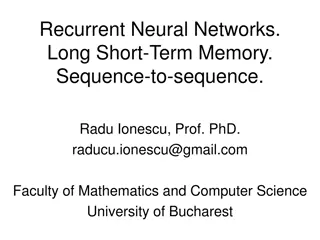Evolution of Neural Models: From RNN/LSTM to Transformers
Neural models have evolved from RNN/LSTM, designed for language processing tasks, to Transformers with enhanced context modeling. Transformers introduce features like attention, encoder-decoder architecture (e.g., BERT/GPT), and fine-tuning techniques for training. Pretrained models like BERT and GPT-3 are commonly used for various NLP tasks due to their effectiveness.
Download Presentation

Please find below an Image/Link to download the presentation.
The content on the website is provided AS IS for your information and personal use only. It may not be sold, licensed, or shared on other websites without obtaining consent from the author.If you encounter any issues during the download, it is possible that the publisher has removed the file from their server.
You are allowed to download the files provided on this website for personal or commercial use, subject to the condition that they are used lawfully. All files are the property of their respective owners.
The content on the website is provided AS IS for your information and personal use only. It may not be sold, licensed, or shared on other websites without obtaining consent from the author.
E N D
Presentation Transcript
Transformers Transformers
Background (1) The RNN and LSTM neural models were designed to process language and perform tasks like classification, summarization, translation, and sentiment detection RNN: Recurrent Neural Network LSTM: Long Short Term Memory In both models, layers get the next input word and have access to some previous words, allowing it to use the word s left context They used word embeddings where each word was encoded as a vector of 100-300 real numbers representing its meaning
Background (2) Transformers extend this to allow the network to process a word input knowing the words in both its left and right context This provides a more powerful context model Transformers add additional features, like attention, which identifies the important words in this context And break the problem into two parts: An encoder (e.g., Bert) A decoder (e.g., GPT)
Transformer model Encoder (e.g., BERT) Decoder (e.g., GPT)
Transformers, GPT-2, and BERT 1. A transformer uses an encoder stack to model input, and uses decoder stack to model output (using input information from encoder side) 2. If we do not have input, we just want to model the next word , we can get rid of the encoder side of a transformer and output next word one by one. This gives us GPT 3. If we are only interested in training a language model for the input for some other tasks, then we do not need the decoder of the transformer, that gives us BERT
Training a Transformer Transformers typically use semi-supervised learning with Unsupervised pretraining over a very large dataset of general text Followed by supervised fine-tuning over a focused data set of inputs and outputs for a particular task Tasks for pretraining and fine-tuning commonly include: language modeling next-sentence prediction (aka completion) question answering reading comprehension sentiment analysis paraphrasing
Pretrained models Since training a model requires huge datasets of text and significan computation, researchers often use common pretrained models Examples (circa December 2021) include Google s BERT model Huggingface s various Transformer models OpenAI s and GPT-3 models
Hugggingface Models Graphical user interface, text, application, email Description automatically generated
OpenAI Application Examples Graphical user interface, application, Teams Description automatically generated
GPT-2, BERT 03
03 GPT released June 2018 GPT-2 released Nov. 2019 with 1.5B parameters GPT-3 released in 2020 with 175B parameters 345M 1542M 117M parameters 762M























